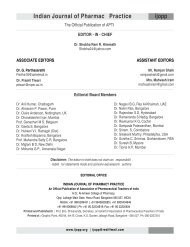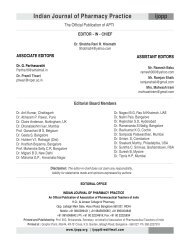<strong>Indian</strong> J. Pharm. Pract. 1(2), Jan-Mar, 2009<strong>APTI</strong><strong>ijopp</strong>Evaluation <strong>of</strong> Drug Information Service provided by Clinical<strong>Pharmacy</strong> Department based on Provider and Enquirers' Perspective1 2 34 5Kuchake V.G , Maheshwari O.D , Surana S.J , Patil P.H , Dighore P.N .1,2,3,4. Department <strong>of</strong> Clinical <strong>Pharmacy</strong>, R.C.Patel Institute <strong>of</strong> Pharmaceutical Education & Research, Shirpur,Dist: Dhule (M.S.), India – 4254055. M.D.(Medicine), Department <strong>of</strong> Clinical pharmacy, Indira Gandhi Memorial Hospital, Shirpur, Dhule,Maharashra-425405*Address for correspondence: msvragavrajan@yahoo.comAbstractHypertension is not a disease but an important risk factor for cardiovascular complication. This type <strong>of</strong> medicalaudit and appropriate feedback on usage <strong>of</strong> antihypertensive medications may greatly assist the health careproviders in rational use <strong>of</strong> medications.The objective <strong>of</strong> this study was to evaluate the prescribing pattern and drugutilisation <strong>of</strong> antihypertensive medications in uncomplicated hypertension. Observational and Prospective studywas performed at Indira Gandhi Memorial Hospital, Shirpur, Maharashtra in India. Total 5025 patients visited themedicine ward <strong>of</strong> Indira Gandhi Memorial Hospital. Among them 244 patients had uncomplicated hypertension.ststFrom 1 July, 2008 to 31 December, 2008 Hypertensive medications were divided into 2 main categories;Monotherapy and Combination therapy was defined and discussed separately. During 6 months study period, 510prescriptions were collected, among them 244 including (132) female & (112) male patients were as per inclusioncriteria. Among them, 150 patients were on mono therapy which included 78 female & 72 male patients, comprising54%(81) on Calcium Channel Blockers, 24.67%(37) on â-Blockers, 11.33%(17) on Angiotensin ReceptorBlockers, 6%(9) on Angiotensin Converting Enzyme Inhibitors, 4%(6) on Diuretics respectively, and 38.52% (94)patients on combination therapy. In the view <strong>of</strong> drug utilisation, it was observed that, the diuretics are lessprescribed and calcium channel blockers are frequently prescribed medications in management <strong>of</strong> hypertension.So, it requires further improvement <strong>of</strong> prescription pattern <strong>of</strong> antihypertensive medication for better patient healthcare.Key Words: Anti-hypertensive drugs, drug utilisation, hypertension, prescribing patternINTRODUCTIONHypertension, a major risk factor for cardiovascular Socio-economic, behavioral, nutritional and public(CV) disease and stroke and one-quarter <strong>of</strong> the adult health issues can lead to increase in CV diseasepopulation <strong>of</strong> Western societies suffer from throughout the world. A plethora <strong>of</strong> new drugs are now(1)hypertension. Increasing awareness and diagnosis <strong>of</strong> available, and the quality <strong>of</strong> life <strong>of</strong> such people can behypertension, and improving control <strong>of</strong> blood pressure improved considerably. A number <strong>of</strong> drugs in variouswith appropriate treatment, are considered critical public(4-5)combinations are generally used for effective long-health initiatives to reduce cardiovascular morbidity and term management. Therefore, drug utilisation studies,(2)mortality. The Seventh Report <strong>of</strong> the Joint Nationalwhich evaluate, analyze the medical, social andCommittee on the Detection, Evaluation, and Treatmenteconomic outcomes <strong>of</strong> the drug therapy, are moremeaningful and observe the prescribing attitude <strong>of</strong><strong>of</strong> High Blood Pressure (JNC VII) is the most prominent(6,7)physicians with the aim to provide drugs rationally .evidence-based clinical guideline for the management <strong>of</strong>(3)The present prescribing study for antihypertensive drugshypertension. Poor control on hypertension can lead towas undertaken in the outpatient department (OPD) atthe development <strong>of</strong> ischemic heart disease, heart failure,Indira Gandhi Memorial (IGM) hospital, Shirpur (ruralstroke & chronic renal insufficiency.area) Maharashtra for the purpose <strong>of</strong> assessing thecurrent trend <strong>of</strong> prescribing pattern <strong>of</strong> anti-hypertensive<strong>Indian</strong> <strong>Journal</strong> <strong>of</strong> <strong>Pharmacy</strong> <strong>Practice</strong>Received on 06/01/2009 Modified on 13/02//2009drugs. This kind <strong>of</strong> medical audit can help to make theAccepted on 17/02/2009 © <strong>APTI</strong> All rights reservedprescribing practice <strong>of</strong> physicians more rational and62
<strong>Indian</strong> J. Pharm. Pract. 1(2), Jan-Mar, 2009prudent and thereby help in improving the patient healthcare.characteristic <strong>of</strong> all 244 uncomplicated hypertensivepatients is seen in Table No. 1.MATERIALS AND METHODFigure No. 1 and 2 shows the social history <strong>of</strong> patientsThe observational and prospective study was carried out like their occupation and education. The data suggestedat IGM hospital to collect the information <strong>of</strong> the patients.The Protocol was prepared as per World Healththat elderly patients having more hypertension amongmore patients were rest. Illiterates are more prevalence(8)Organization (WHO) guidelines and study was than literates.approved by Institutional Human Ethical Committee Overall, 150 (61.48%) patients were treated with a single(IHEC) <strong>of</strong> R.C.Patel Institute <strong>of</strong> Pharmaceutical anti-hypertensive drug and 94 (38.52%) patients wereEducation & Research, Shirpur.treated with anti-hypertensive drug combinationsStudy design: This study was observational and suggesting that mono-therapies to be dominant in thisprospective conducted over the 6 months periods from type <strong>of</strong> rural area.st st1 July 2008 to 31 December 2008 for assessing Table No 2 shows the details <strong>of</strong> patients, who wereprescribing pattern and drug utilisation <strong>of</strong>antihypertensive drugs in the management <strong>of</strong>treated with monotherapy. Among them, 81 (54.0%)patients were treated with Calcium Channel Blockersuncomplicated hypertension(CCBs), 37 (24.67%) were treated with â-blockers,Study site: The study was carried out at the Medicine 17 (11.33%) with Angiotensin receptor blockers(ARBs),ward <strong>of</strong> IGM hospital <strong>of</strong> Shirpur for collection <strong>of</strong> data. 9(6.0%) were treated with Angiotensin ConvertingStudy setting: The study was carried out on out patients Enzyme Inhibitors(ACEIs), and 6(4.0.%) treated with<strong>of</strong> medicine ward, who were currently following the diuretic. Calcium channel blockers were the mosttreatment <strong>of</strong> uncomplicated hypertension in IGM frequently prescribed antihypertensive drugs ashospital, Shirpur.monotherapy.Source <strong>of</strong> data: All necccesary & relevant information Figure No.3 show details <strong>of</strong> patients treated withwere collected from out patient department cards, combination therapy. Among them 59, (62.78%) werelaboratory data report, treatment chart and verbal treated with two drugs, 31(32.98%) with three drugs andcommunication with patients.4 (4.25%) were treated with 4 drugs.Collection <strong>of</strong> data: The format for the collection <strong>of</strong> the It was observed that eight different two-drug antithedata is prepared as per WHO based guidelines andhypertensive combinations, were prescribed to hyp-Institutional Human Ethical Committee <strong>of</strong> R.C.Patel ertensive patients (Table no.3), namely: , â –blocker withInstitute <strong>of</strong> Pharmaceutical Education & Research, CCB 23 (32.98%), ARB with diuretic 18(30.51%), CCBShirpur which involved patient as well as medication with diuretic 6(10.17%), â-blocker with diureticinformation.4(6.78%), ARB with CCB 4(6.78%), ACEI with CCBInclusion criteria: Patients either male or female with2(3.38%), ACEI with diuretics 1 (1.69%) and ARB withage more than 18 years, with History <strong>of</strong> hypertension orâ-blocker1 (1.69%).currently diagnosed with hypertension and prescribed The CCB with â-blocker was the most frequentlyprescribedtwo-drug combination in overall populationwith antihypertensive medication.Exclusion criteria: Patients with other comorbiditiesfollowed by ARB with Diuretic. The CCB with â-blockerlike diabetes, other cardiovascular disorders, stroke,were less prescribed in male than female patients due toasthma, Chronic Obstructive Pulmonary Disease(9)side effect <strong>of</strong> â-blockers in male patients.(COPD), arthritis, and other infectious disease.DISCUSSIONStatatical Data AnalysisA Prescription-based survey is considered to be one <strong>of</strong>The t- tests (Unpaired, Two tailed) were used forthe most effective methods to assess and evaluate drugevaluation <strong>of</strong> mean S.E.M. (Standard Error Mean) <strong>of</strong> ageutilization <strong>of</strong> medication. It is also important to considerand blood pressure <strong>of</strong> patients. A value <strong>of</strong> P0.05 (twotherecommendations <strong>of</strong> international bodies ontailed test) was declared as statistically significant.hypertension that help to improve prescribing practice <strong>of</strong>RESULTSst stDuring 6 months study from 1 July 2008 to 31 the physicians and ultimately, the clinical standards. ADecember 2008, total 5025 out patients visited the continuous supervision is therefore required throughmedicine ward <strong>of</strong> hospital, among them, 510 patients such kinds <strong>of</strong> systematic audit that provide feedbackwere diagnosed with hypertension <strong>of</strong> which 244 had from the physician and help to promote rational use <strong>of</strong>uncomplicated hypertension. The demographic drugs.63
- Page 1:
Indian Journal of Pharmacy Practice
- Page 4 and 5:
Indian Journal of Pharmacy Practice
- Page 7 and 8:
APTIIndian J. Pharm. Pract. 1(2), J
- Page 10 and 11:
Indian J. Pharm. Pract. 1(2), Jan-M
- Page 12 and 13:
Indian J. Pharm. Pract. 1(2), Jan-M
- Page 14 and 15:
APTIijoppGenesis, Development and P
- Page 16 and 17:
Indian J. Pharm. Pract. 1(2), Jan-M
- Page 19 and 20: Indian J. Pharm. Pract. 1(2), Jan-M
- Page 21 and 22: Indian J. Pharm. Pract. 1(2), Jan-M
- Page 23 and 24: Indian J. Pharm. Pract. 1(2), Jan-M
- Page 25 and 26: Indian J. Pharm. Pract. 1(2), Jan-M
- Page 27 and 28: Indian J. Pharm. Pract. 1(2), Jan-M
- Page 29 and 30: Indian J. Pharm. Pract. 1(2), Jan-M
- Page 31 and 32: Indian J. Pharm. Pract. 1(2), Jan-M
- Page 33 and 34: Indian J. Pharm. Pract. 1(2), Jan-M
- Page 35 and 36: Indian J. Pharm. Pract. 1(2), Jan-M
- Page 37 and 38: Indian J. Pharm. Pract. 1(2), Jan-M
- Page 39 and 40: Indian J. Pharm. Pract. 1(2), Jan-M
- Page 41 and 42: Indian J. Pharm. Pract. 1(2), Jan-M
- Page 43 and 44: Indian J. Pharm. Pract. 1(2), Jan-M
- Page 45 and 46: Indian J. Pharm. Pract. 1(2), Jan-M
- Page 47 and 48: Indian J. Pharm. Pract. 1(2), Jan-M
- Page 49 and 50: Indian J. Pharm. Pract. 1(2), Jan-M
- Page 51 and 52: Indian J. Pharm. Pract. 1(2), Jan-M
- Page 53 and 54: pivotal to the rational use of medi
- Page 55 and 56: .leadership” (Cohen, 1984). A stu
- Page 57 and 58: Indian J. Pharm. Pract. 1(2), Jan-M
- Page 59 and 60: Indian J. Pharm. Pract. 1(2), Jan-M
- Page 61 and 62: Indian J. Pharm. Pract. 1(2), Jan-M
- Page 63 and 64: Indian J. Pharm. Pract. 1(2), Jan-M
- Page 65 and 66: Indian J. Pharm. Pract. 1(2), Jan-M
- Page 67: Indian J. Pharm. Pract. 1(2), Jan-M
- Page 71 and 72: Indian J. Pharm. Pract. 1(2), Jan-M
- Page 73 and 74: Indian J. Pharm. Pract. 1(2), Jan-M
- Page 75 and 76: Indian J. Pharm. Pract. 1(2), Jan-M
- Page 77 and 78: Indian J. Pharm. Pract. 1(2), Jan-M
- Page 79 and 80: Indian J. Pharm. Pract. 1(2), Jan-M
- Page 81 and 82: Indian J. Pharm. Pract. 1(2), Jan-M
- Page 83 and 84: Indian J. Pharm. Pract. 1(2), Jan-M
- Page 85 and 86: Indian J. Pharm. Pract. 1(2), Jan-M
- Page 87 and 88: Indian J. Pharm. Pract. 1(2), Jan-M
- Page 89 and 90: Indian J. Pharm. Pract. 1(2), Jan-M
- Page 91 and 92: Indian J. Pharm. Pract. 1(2), Jan-M
- Page 93 and 94: Indian J. Pharm. Pract. 1(2), Jan-M
















